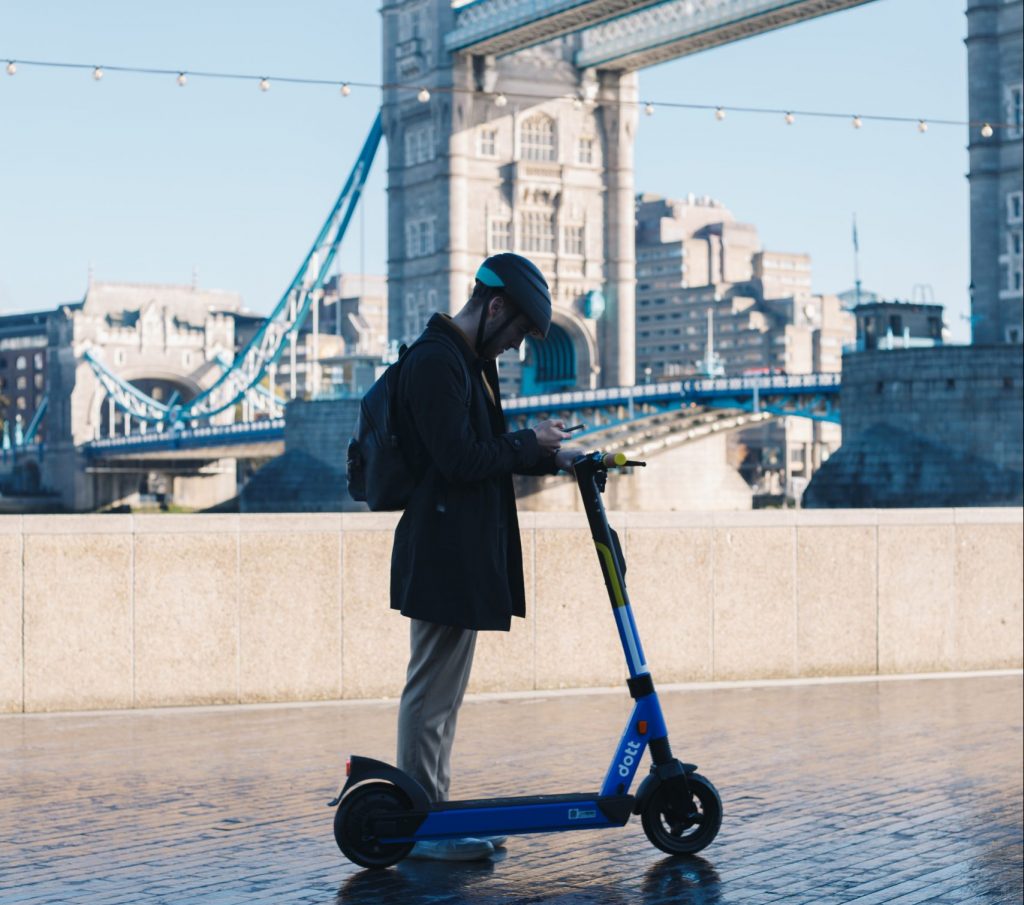
Think tank Centre for London called for both private and shared e-scooters to be legalised in the UK in a report published last month.
Titled Micromobility in London, it urged the government to legalise the use of e-scooters on public roads, while handing control of the London scheme in particular to Transport for London.
Following the publication of the prominent report, Josh Cottell, Research Manager at Centre for London, spoke exclusively to Zag Daily about how it put its findings together and why change is required.
Zag Daily: What was the purpose behind putting this report together?
JC: “With the COVID-19 pandemic and the ramifications that are still ongoing, such as the changes to the way that people travel around the city, there seems to be a real risk that people who previously opted for public transport might start using private cars more often, which would undo a lot of progress that has been made in London over the last couple of decades. We also have a climate emergency and the subsequent plans for London to reach net-zero carbon dioxide emissions by 2030. With that in mind, transport is the cause of a quarter of the city’s carbon dioxide greenhouse gas emissions, so it seems likely that we will need to see a significant change in how people move around in the coming years. Increasing demand for micromobility can certainly play an important role in enabling people to move around the city in a sustainable, fun, and convenient way, so that was the origin of the project.”
Zag Daily: How did you go about collecting data and coming to the final recommendations?
JC: “We conducted a review of literature from the UK, where we mostly know about pedal bikes because they have been around for the longest, and from international studies which look into e-scooters and e-bikes and the impact these modes have had on transport systems and cities around the world. We also spoke to experts and assembled an advisory group that included people from different fields and organisations to help to inform our work.”
Zag Daily: What were the key findings from the report?
JC: “Pre-pandemic, just two per cent of trips made in London were by bikes, which is quite a low proportion especially when compared to a place like Amsterdam, where you have almost a quarter of journeys being made by bike. But it just goes to show how different things could be in a different set of circumstances. So, we looked at what would happen if more people used micromobility. One of the key benefits that appears to come from the use of micromobility when compared to a private car is environmental through lower greenhouse gas emissions. Vehicles which run by either electric motors, human propulsion, or a combination of the two – bikes, e-bikes, and privately owned or shared e-scooters – produce less carbon dioxide than private cars for the same number of people travelling. There are several studies on this, and the estimates vary slightly from study to study, but the most consistent data set that we were able to find was clear that micromobility vehicles emit less than private cars. It is also true that as electric motors become more efficient with technology improving, and as the electricity is drawn from more renewable sources, that the environmental impact will decrease. If we get to a point where more people feel able to take fewer journeys by car and more using micromobility, then we might see quite a substantial impact on the carbon dioxide emissions.”
Zag Daily: Did you notice any differences in terms of congestion and air quality?
JC: “We looked at the impact on both, and we found that micromobility can help to reduce congestion, because these vehicles will take people out of their cars and onto devices that take up much less space on the road. We’re not suggesting that we take people’s cars away, but if people are able to take more trips using micromobility, it will free up quite a lot of road space quite quickly. There was evidence from Imperial University, which looked at the introduction of cycle lanes in different parts of London and it found that where they have been implemented, although they took up some road space, congestion on those streets did not increase. On air quality, micromobility devices produce far fewer pollutants compared to a car. So, when you make that sort of comparison between micromobility and cars, there are a lot of benefits to increasing the offering. Micromobility is also compatible with public transport. We found that two thirds of car journeys in London can be accessed by bike, e-scooter or e-bike in 20 minutes or less, so provided there is a safe cycle lane and parking at more destinations, more people may feel encouraged to take an e-scooter to the train station, instead of driving.”
Zag Daily: What did you learn about the risks associated with micromobility?
JC: “We looked at data from London to determine the risk of fatal or serious injury to people, depending on which type of vehicle they’re travelling on. This showed that motorcycles have, by a fair margin, the highest risk to other road users, followed by taxis, cars, goods vehicles and then bicycles. They are bettered only by buses and coaches, so bicycles tend to be a safe way of getting around. There is less research on the risk associated with e-scooters and e-bikes, but the few international studies there have been suggest that it is similar to that posed when riding a pedal bike. So, we can feel confident that all three of these modes are relatively safe modes of transport. Another risk we looked at was whether micromobility would be accessible to all Londoners, whether that be because they feel unsafe riding without a wide cycle lane, or because the parking is not affordable or easy to use. There are also other barriers such as the financial cost of buying a private e-scooter. To help resolve this, we are recommending a suite of measures that will enable more people to use micromobility and help us achieve the biggest gains in terms of moving people towards more sustainable modes of transport.”
Zag Daily: How important is the role of infrastructure in terms of micromobility being adopted more widely?
JC: “Infrastructure can play a significant role in how safe people feel using these different modes. Having a cycle lane which is off the pavement, where riders are not endangering pedestrians but also segregated from the road, can enable people to feel a lot safer from cars and traffic while riding an e-scooter or e-bike. This also has a benefit for pedestrians who are not at risk of being hit by one of these vehicles, and for people in cars who do not have to worry about more vehicles arriving at unexpected places in the road. Secondly, micromobility vehicles work together really well. If we implement decent cycle lanes that are in line with current demand and potential future demand, then not only will people feel better able to ride a bicycle, but that will have a benefit for people on e-scooters and e-bikes. We have found that these modes really rise and fall together because they have lots of shared features, despite being distinct modes of travel. We are also advising that the London cycling design standards are updated to reflect the needs of users, who need access to safe parking that is accessible and consistent across different areas.”
Zag Daily: Why do you think the recommendations made in the report are necessary?
JC: “So, one of the key recommendations is that the use of private and shared e-scooters should be legalised on public roads, and somewhat understandably there are some concerns about potential safety risks for pedestrians. Part of the reason we are recommending these measures is because it is clear that these vehicles are being used, with or without legalisation. These vehicles are here already, and government policy needs to catch up and reflect this in order to encourage safe driving and enable more people to use these different modes. What we are recommending is not legalisation on its own or infrastructure by itself. These changes will work best if they are part of a package, where we enable the police to enforce the laws because tackling unsafe driving at the moment is a bit of an impossible task. We are also recommending that shared operators use penalties and rewards to encourage safe riding and parking. That might include price incentives to discourage people from rushing through traffic, and education to ensure people use a helmet. Finally, we recommend that TfL is given the power by national government to manage shared micromobility schemes. This is because there are currently differences between boroughs in terms of accessibility to both devices and parking, which is unfair. These inconsistencies between boroughs make it difficult to ride and very frustrating for riders travelling longer distances. We think that if TfL is given the power to organise the shared scheme on a London-wide level, it can use its ability to negotiate on a city-wide basis and ensure accessibility right across the city.”
Zag Daily: Was there anything from the research that surprised you?
JC: “What has surprised me is how people view the distinction between e-scooters and other forms of micromobility. It is worth remembering that in a lot of very important ways, e-scooters are very similar to pedal bikes, especially when you put measures in place such as speed limiters. E-scooters can be easily ridden alongside bicycles and e-bikes in cycle lanes, provided that the lanes are big enough for people to feel safe. They also appeal to a different group of people, which is important because choosing whether to cycle or not is not a genuine choice for a lot of people in London, with most riders tending to be young and male, and more likely to be employed than the general population. Therefore, it is great to see that e-scooters and e-bikes appeal to a broader section of society, and this should be encouraged and built on through legislation.”
